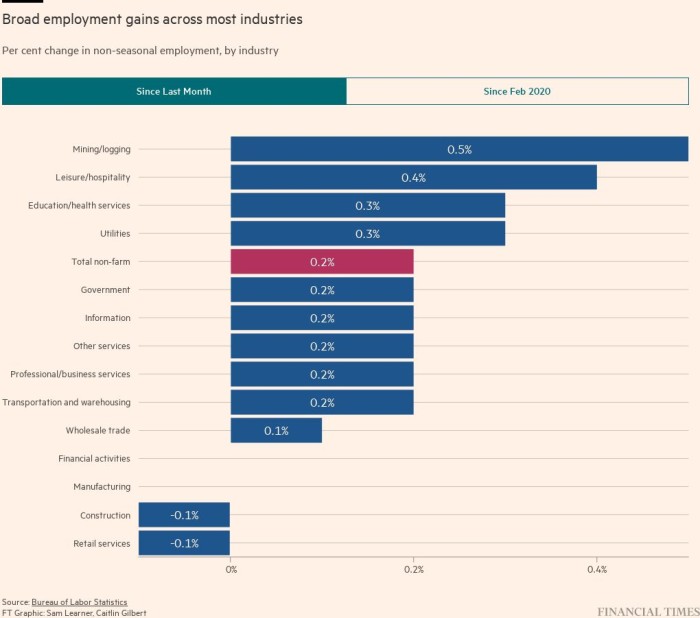US job growth slowed in March, but it wasn’t enough to deter the Federal Reserve from considering raising interest rates again as the central bank battles high inflation.
The world’s largest economy added 236,000 jobs last month, according to a report from the Bureau of Labor Statistics published on Friday. This was down from the 326,000 upwardly revised jobs due in February and significantly lower than the 472,000 jobs recorded in January. Most economists polled by Bloomberg expected a job gain of 230,000 jobs in March.
Over the past six months, monthly job gains averaged 334,000, according to the BLS.
The unemployment rate has fallen to 3.5 percent, just above its lowest level in several decades. Meanwhile, wage growth remained flat, with average hourly earnings rising 0.3 percent in March after a 0.2 percent increase in the prior period.
On an annual basis, wages increased by 4.2 percent. This is the lowest reading since mid-2021, indicating easing inflationary pressures.
“There are some indications of gradual weakening in labor demand,” said Eric Winograd, economist at Alliance Bernstein. “We may be seeing some cooling, but we don’t see the kind of cooling that would bring the economy back into balance that would take the pressure off inflation in the short term.”
He added, “The question we all face is whether the turmoil in the banking sector is sufficient to do that, and it is too early to tell.”
US government bonds came under selling pressure, with the policy-sensitive two-year Treasury yield adding 0.15 percentage point to 3.98 percent in a brief session. The benchmark 10-year yield rose 0.09 percentage point to 3.39 percent, according to Bloomberg data. Yields go up when prices go down.
US stock markets are closed on Good Friday. Prices in the futures markets indicated that investors continued to believe that the Fed had implemented the last interest rate hike of the cycle. And in a statement released on Friday, President Joe Biden said recent data indicates that the United States is “continuing[s] To meet economic challenges from a position of strength.
The jobs report follows other data this week that provided initial signs that a year-long effort by the Federal Reserve to tame inflation is starting to weigh on the historically strong labor market. The unemployment claims numbers, which tracks new applicants for unemployment assistance, came in higher than expected Thursday and numbers over the past 12 months were revised higher as part of the annual review by the BLS.
Data on Wednesday showed that job vacancies in the United States also fell sharply in February, sending the proportion of jobs available for the unemployed down to 1.7 from 1.9.
“If I were to make a topic for this jobs report, it’s clearly on its way to normal,” said Christina Huber, chief global market strategist at Invesco.
“This, to me, tip the scales in favor of the more dovish Fed going forward.”
Fed officials emphasized that it would take a period of “below trend growth and some softening in labor market conditions” to bring inflation back to the central bank’s 2 percent target. Most policymakers expect, based on forecasts published last month, that the unemployment rate will rise to 4.5 percent this year and that growth will slow to 0.4 percent as they advance their tightening campaign.
After another quarter-point rate hike last month, the federal funds rate is between 4.75 and 5 percent. Most officials see it peaking between 5 and 5.25 percent this year and expect no cuts until 2024, suggesting markets are waiting for another quarter-point increase.
Complicating the outlook for the Fed, however, is the extent of the economic shock created by the recent banking turmoil. Federal Reserve Chairman Jay Powell and other officials have suggested that a credit crunch is likely as lenders pull back, but the size of the downturn is highly uncertain.
“Such a tightening in financial conditions would work in the same direction as a rate tightening,” Powell said last month, adding that it would likely amount to “a rate hike or perhaps more than that.”

According to Friday’s data, leisure and hospitality jobs led the March gain, with 72,000 jobs added. This is a decline from the average monthly profit of $95,000 over the past six months. Employment across government rose by 47,000, while employment in professional and business services rose by 39,000.
Among the sectors that will be eliminated, the retail sector was the one with the largest losses, as it amounted to 15,000 jobs. Warehousing and warehousing jobs shrank by 12,000.

“Beer fan. Travel specialist. Amateur alcohol scholar. Bacon trailblazer. Music fanatic.”
